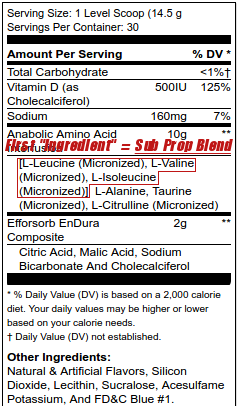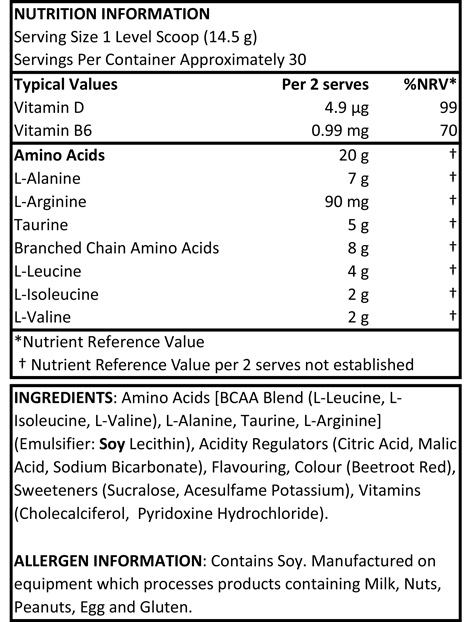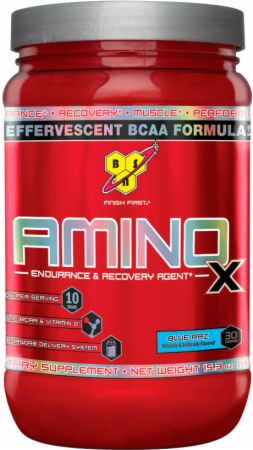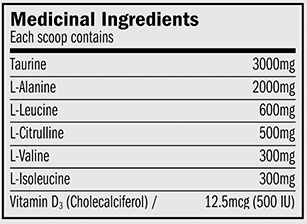When reading a label, you have to be extremely careful, as you're going to see today.
Usually on the PricePlow blog we cover the newest products, interesting studies, or fun reviews. Today, we turn our attention to the Canadian and European side of the industry, where supplement labels are more open and help educate the consumers more than in America.
This gives us a glimpse as to what's going on inside the product - and although it's often not the same exact label as the American one, it's close enough to get some ideas within the ones listed below in PricePlow (we work mostly with American stores).
Before we go, take a look at the prices to get an idea for what people are paying for:
BSN Amino X – Deals and Price Drop Alerts
Get Price Alerts
No spam, no scams.
Disclosure: PricePlow relies on pricing from stores with which we have a business relationship. We work hard to keep pricing current, but you may find a better offer.
Posts are sponsored in part by the retailers and/or brands listed on this page.
Some Background
First, a little primer on how supplement facts work on products in America. When looking at the long list of ingredients on the side of a packaged product that utilizes a proprietary blend, the ingredients should be listed in order of weight. Pulled straight from the FDA website:
You must identify proprietary blends by use of the term "Proprietary Blend" or an appropriately descriptive term or fanciful name. On the same line, you must list the total weight of all "other dietary ingredients" contained in the blend. Indented underneath the name of the blend, you must list the "other dietary ingredients" in the blend, either in a column or linear fashion, in descending order of predominance by weight. These ingredients should be followed by a symbol referring to the footnote "Daily Value Not Established." Dietary ingredients having RDIs or DRVs must be listed separately and the individual weights declared.[1]
Basically, this means that in a prop blend the first ingredient listed will be present in a greater or equal amount than the ingredient listed following it.
What’s Going On?

BSN's Amino-X faces heavy scrutiny after the Canadian Supplement Facts label illuminated some questionable practices on the American label. Notice that the first "ingredient" is really a proprietary blend of the three BCAAs. It's possible that there's more Alanine (and even taurine) than each individual BCAA!
Ok, now that you understand how prop blends and supplement facts panels work, we can get to the real meat of the story. BSN has been around the supplement game a LONG time and one of their popular products is their amino acid supplement, Amino-X.
Watch out for those brackets!!
Looking at the U.S. supplement facts panel, you can see that the amino blend weighs in at 10g and consists of [Leucine, Valine, Isoleucine], Alanine, Taurine, and Citrulline, in that respective order.
The brackets are what's most important!!
With America's FDA guidelines, the combination of [Leucine + Valine + Isoleucine] should contribute the highest (or equal to the highest) amount to the blend. Yet, not necessarily leucine itself.
But is that how you read the label just now? Because at a glance, it certainly looks like leucine is first (and thus most). Not so fast:
When you bracket the three BCAAs (which are indeed the most important ingredients) into "one ingredient", it's now possible that the next ingredient -- alanine -- could actually have more prevalence than each individual BCAA!
And that just might be what's happening...
Canada to the Rescue!
Aside from maple syrup, one of the great things about our friendly neighbors to the north is that their supplement regulation guidelines are more stringent than here in the States. In Canada, though, supplement companies may be made to list the exact amount of certain amino acids in a product -- this means no hiding behind proprietary blends if the product contains histidine, isoleucine, leucine, lysine, methionine, phenylalanine, threonine, tryptophan and/or valine.[2]
Now, this is a double-edged sword. Companies that have nothing to cover up willingly embrace the transparency and use it as a beacon to stand behind the quality of their products, showing that they go above and beyond what the law requires. But other companies that are less than honest stand something to lose.
The Canadian Amino-X Label
Looking at the Canadian Supplement Facts for BSN’s Amino-X (which was posted on Popeye's, a popular Canadian supplement store),[3] we can see Leucine is not present in the highest amount, but instead Taurine is, weighing in at 3g of the 6.7g blend! Leucine is a paltry 3rd runner in the race, and only contributes 600mg to the 6.7g blend!
So in Canada, taurine and alanine contribute to 74.6% of this formula -- nearly three-fourths go to these two cheap aminos!! Note that these are two of the amino acids frequently implicated in the whole amino acid spiking fiasco from 2013-2014 whose lawsuits are just now starting to get settled...
So first and foremost, we're definitely not recommending Canadians buy a 30 serving tub of this for more than say, $3 US dollars.
But what about a suggested strike price for Americans? We're not so sure there, because of the prop blend:
It's definitely different than the American one
Now, since alanine comes before taurine on the American label, we know that the Canadian and American Amino-X products are definitely different and we cannot draw any real conclusions on the American label. But we can still learn and wonder about a few things.
So what's going on here? Potentially a couple of points:
-
The US and Canada/Europe are likely getting different versions of the same product name.
-
...we believe that this practice is potentially deceptive and preys on consumers not being subject matter experts on FDA label regulations.
In America, something like the following might be going on where the BCAAs in brackets [Leucine + Valine + Isoleucine] = 2500mg, from something like 850mg leucine, 850mg valine, and 800mg isoleucine.
However, the inexpensive alanine could then be at 2500mg -- more than each individual amino acid, but not more than the combined "bracketed" set of BCAAs.
(In this example, Taurine and L-Citrulline would also then be 2500mg, yielding a total of 10g, proving that this is in fact possible)
Confused? You're probably not alone in thinking so.
Questions for BSN:
We request that BSN contact us and publicly answer the following questions on the record:
- Why make different products for the US and Canada? These are different products that get different production runs, right?
- How much actual leucine, valine, and isoleucine are in the American version of Amino-X?
- Will you release full, third-party lab tests of Amino-X disclosing what is found to be inside of this formula from a tub that has been purchased from a reputable store's shelf?
Ultimately, it's possible that consumers who thought they were getting a well-rounded dose of BCAAs are in fact possibly only getting a fraction of what’s ideal in an industry-leading amino acid product.
Is this deceptive practice?
Let us be real clear: this is legal per the FDA's guidelines. As long as what's listed on the product is inside and in the right order / ratios, BSN and all other companies are following the FDA's laws and it isn't "illegal" in the sense of a labeling violation.
HOWEVER,
In our strict opinions, we believe that this practice is potentially deceptive and preys on consumers not being subject matter experts on FDA label regulations.
Proprietary blends are bad enough as it is. But to have a sub-proprietary blend quickly bracketed into a primary proprietary blend takes things one step too far for our liking.
We would love to conduct a survey to see how many users think that leucine is the most prevalent ingredient on this label - we're guessing it's a relatively high number.
It even happened to us - we look at labels all day and it still took us some time to see what was going on in the US label when comparing to the Canadian label.
The European Label!
Note: This section was updated on March 24, 2016, two days after this post was originally published:
LionakisPersonalTrainingMethods on Facebook contacted us with a link to the European Label,[4] shown below. Take a look at it below:

Our European friends definitely get more BCAAs than the Canadians... but see something odd about this? (Hint: Per 2 serves)
Can you spot any confusion on this label?
It's a 14.5g scoop, but individual ingredient doses are given for TWO servings. So if you're quickly scanning for the BCAA numbers, do not be tricked!
Even with that said, this label is clearly better that what's up in Canada: A 14.5g scoop yields 3.5g alanine, 2.5g taurine, 4g BCAA from 2g leucine + 1g valine + 1g isoleucine -- solid -- and an odd 45mg arginine.
So while the 4g BCAAs are definitely beneficial here, why list the doses of two serves and not also one? Why can't we just get a simple, straightforward label?
If you list doses in only two servings, then is it even a "30 serving tub" anymore?
Please, BSN, quit this nonsense and re-do these labels the right way. Legal or not, this is ludicrous and seems to have no good intention.
(End of update)
Where to go from here?
Basically, this is another reason for our argument against proprietary blends in the United States. The cons simply far outweigh the pros - especially for the consumers. Too many companies use these blends to their financial advantage, and it ultimately allows for cheap ingredients to obfuscate and outweigh the more expensive ones (which oftentimes happen to be more beneficial).
Until the FDA gets around to closing these kinds of "loopholes", the answer is to either only support companies who transparently list their ingredients, OR, support those companies who offer 3rd party testing for all of their products, verifying that the label's contents matches what’s inside the tub.
We cannot in our right minds recommend a BSN product
All in all, until we hear back from BSN, we will not be recommending any of their products. Sure, this is only one instance, but as the saying goes... "Fool me once, shame on you. Fool me twice... shame on me"
For now, all we can do is aware the public to situations such as this as they come to light and point them in the direction of companies who aren’t trying to pull the rug out from their consumer base.





Comments and Discussion (Powered by the PricePlow Forum)